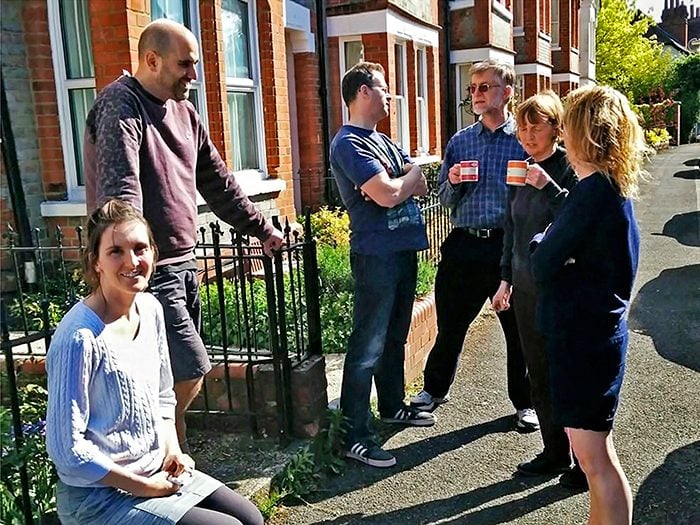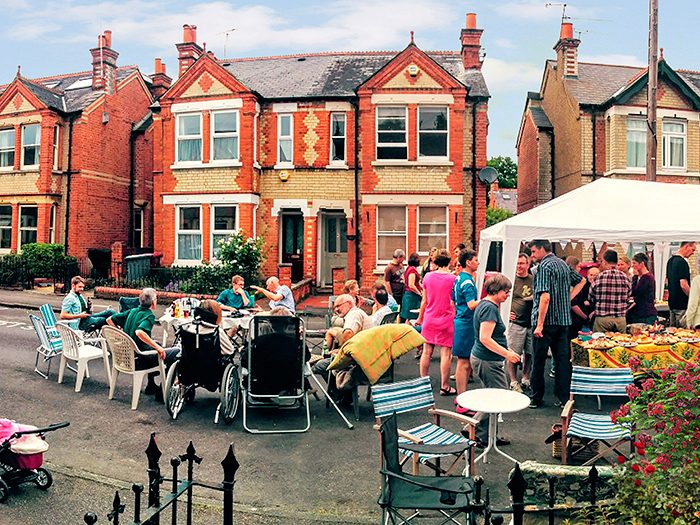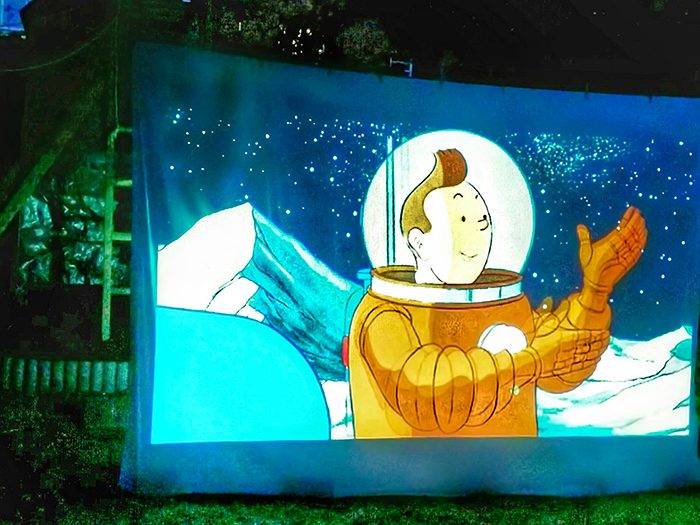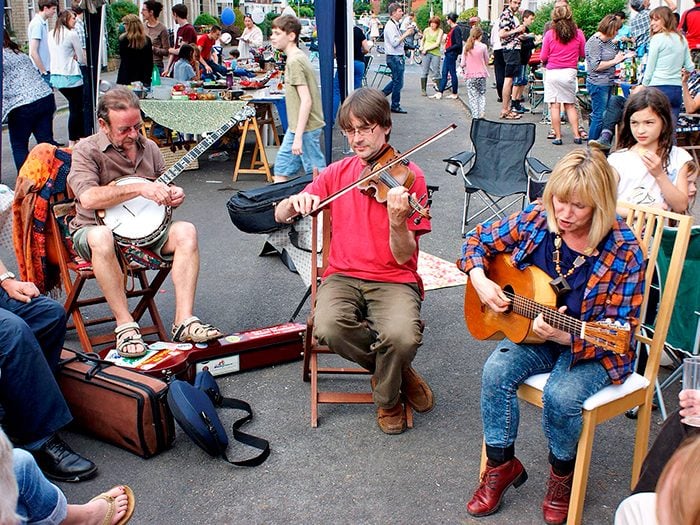The Friendly Street
What makes a thriving community? These neighbors have the answer.

What is it about Talfourd Avenue? On the face of it, it’s just another street of small but smart semis in east Reading, 60 kilometers west of London. True, it’s handy for the number 17 bus into town, and it’s close to the local university and a rather pleasant lake. But you could say the same for plenty of other streets in the vicinity.
The first clue that something unusual is happening in Talfourd Avenue is perhaps the large planter on the corner at one end. As one of the children who lives in the street, says, “There are lots of different types of flowers in it. Anyone can plant flowers there. If they’re all dying, some of us will meet up and water them.”
A communal planter? Neighbors doing things together? While British TV soap operas depict a nation of families that meet up in the local pub each night and are in and out of each other’s houses on a regular basis, the reality is rather different.
But Talfourd, as its residents like to refer to the street, is not like that. “I remember when we first moved here, it soon became apparent that people were friendly,” says Jane, who works for the British government’s Environment Agency.
“When we moved in, several people just came up and chatted to us and asked who we were. I’d never known that before!” says web designer Karly.

“The first time I discovered what it’s like was our first Christmas. Carol singers came to our door and sang ‘Away in a Manger’. I thought they must be doing it for charity, but they weren’t, they were just doing it for the joy of singing and sharing,” says Rachel, who works at Reading University.
And there’s more to Talfourd than just a welcoming spirit. Take the case of Marion and Simon. One Christmas, Marion broke her leg, and shortly afterwards, Simon fell down some stairs and broke his foot.
Both of them were incapacitated, making it difficult to look after themselves and their three children. So the residents of the street helped out in all sorts of different ways: taking their kids to school, washing Marion’s hair, getting their shopping, and more.
“We helped them for about three or four months,” says Nicola, who works as a speech therapist. “People do lots of small favors for others here. When I talk to my friends about the street, a lot of them say, ‘Gosh, I wish I lived in a place that was as friendly as that.’
“But some people think it’s an awful idea. My brother said he’d hate to live somewhere like this, where everybody knows everybody else, and there’s no anonymity. But I don’t find it overwhelming, we’ve all got our own lives.”
Nobody is quite sure when Talfourd became such a beacon of good neighborliness, but it seems to go back decades. Chris, now a retired teacher, moved here with his wife, Sue, in 1988. Even back then the street was known for its communal spirit. “Sue decided that of all the places in the world she wanted to live, it was here, because of the great relationships between people,” says Chris. “Obviously a lot of the older people that we knew when we moved in have gone now but, if anything, it’s developed more. The next generation have really taken things further.”
Indeed they have. In recent years, several regular events have been instituted in the Talfourd calendar. There’s the Big Lunch, an annual street party that takes place in the summer; Talfest, a mini music festival featuring local performers; a coach trip to the seaside; a picnic at the nearby park; a film club; a street choir; and Playing Out, when Talfourd is closed to traffic to allow children (and adults) to play in the street.
It sounds like the result of regular committee meetings, but in fact it’s all pretty freeform. As far as organization goes, a letter is sent out once a year to everyone in the street setting out the main events, and that’s about it. Anyone can instigate new activities if they want, and they’ll usually find a receptive audience.

“We’re a very unusual street, but in a good way,” says Rachel, who’s one of Talfourd’s prime movers. “There’s a real mix of people who live here, and almost everyone gets involved in one way or another, but not everyone’s going to get involved in everything.”
“We’re not in each other’s pockets all the time,” says Rick, who works in the air conditioning business. “And it’s not that we’re all similar people. But there’s a real sense of enthusiasm. Whenever someone comes up with a suggestion, whatever it is, people just go, ‘Yeah!’”
So could we all be a bit more Talfourd? Rachel thinks so. “Even if you just do a Big Lunch once a year or do a Playing Out, give it a go,” she says. “Things will grow from that.”
And where does Talfourd go from here? There will be new events added to the calendar, we can be sure of that. And there’s even talk of taking a bit of Talfourd to the rest of Europe and twinning with other streets on the Continent.
Any takers out there?
The Big Lunch
Jan: “The first ever Big Lunch event took place in 2009 after my husband Andrew read about an initiative to get people to hold street parties together. We thought we could hold a lunch on the nearby allotments for fellow plot holders and neighbors from Talfourd. We had around 36 people on the day and we decided that it was an event worth repeating.
“The following year we ended up meeting on the pavement outside our house, then in 2011 the town council started granting free street closures, so we collected signatures and submitted an application. Andrew died suddenly shortly afterwards and there was a question as to whether the event should go ahead. I felt that it was vital that it did and it turned out to be even bigger than we could have hoped. The following years have seen it grow into a highlight of our social calendar. It’s the most wonderful tribute to Andrew.”
Chris: “It always begins with what I think of as the comedy of the gazebo going up. There are three brothers and their families who live in the street and one of them owns an enormous gazebo, so the first thing that happens after the street is closed at noon is they get out all the bits of this gazebo and put it together.
“Then people bring down the tables and chairs and the bunting starts to go up. There’s a PA system and people bring instruments along. Everyone brings food and it’s put out and shared. There’ll be about a hundred people all together.”

The Film Club
Nicola: “There are 16 of us involved from the street and we’ve been doing it for eight years. It’s a bit like a book club. We take it in turns to host, and whoever’s hosting is responsible for picking the film, which we watch together. Alcohol is generally involved, and people do quite elaborate snacks.
“We tend to watch a lot of films from overseas, some of them quite thought-provoking, although not always. The lowlights have included an Icelandic film called Rams, which the woman over the road told us was really funny, but turned out to be a film about scrapie in sheep and two farmer brothers who had fallen out with each other. It was the most depressing film we’ve ever watched.
“The highlights have included Little Miss Sunshine, which is an unremittingly cheerful film, and a German film about a teacher who decides to try and show people what living in a totalitarian regime is like. For Sue’s 70th birthday we watched a black-and-white film from 1946 called Stairway To Heaven, which was really quite remarkable.”
Talfest
Karly: “The first year it was just Simon and Hilary, two professional musicians who were living in the street, who played, and everyone brought some food. It was a bit like a street party but with some music. We didn’t even call it Talfest until the second year. We’re a bit embarrassed by the name, to be honest!”
Jane: “We hold it in the back garden. We open the doors of the patio and take the fence panels down between our house and Karly’s. It’s grown massively in the last five years. At the last one we started with some kids in the street who are about 13 or 14 with their own little band. Then there was a ukulele band, Simon and Hilary again, a guy who sings with an accordion who’s incredibly talented, and more.
“There must have been about 120 people who came along. The music stops at ten o’clock, because we’re very aware of neighbors in the next street, but people are out until three in the morning.”
Playing Out
Rachel: “It started in October 2013. My mum saw an article in a national newspaper about Playing Out, which is a grassroots movement, and said, ‘This might be something you’d like in your street.’ With the support of some of our neighbors, I lobbied the council to get permission to close the street.
“It happens every second Saturday of the month. We put wheelie bins across the top of the street, and have special ‘road closed’ signs. People can still drive in, but they need to be escorted by someone walking in front of the car with a whistle—we have volunteers who agree to stand at either end to act as stewards.
“The idea is for the kids to get a bit more freedom, as well as health benefits, but it’s not just for kids. Sometimes we have a theme, such as Valentine’s Day or Bake Off. I never played in the street when I was a child, my parents wouldn’t have let me.”
The Coach Trip
Rick: “We did it for the first time in July last year. The idea came up in the pub. When I was a kid, we used to do road trips to the beach, and I said to a mate, ‘What do you reckon if we hired a bus?’ And he said, ‘Yeah, great!’
“We just dropped an email round and there was a pretty unanimous yes, so 49 of us and a dog went on a day trip to Bournemouth. The coach picked us up at nine in the morning and we all took a picnic, which we ate on the beach.
“The weather was awful and we were all wearing coats, but half of us still went in the sea. At five o’clock we all got back on the coach and we were home by 6:30. We’re definitely doing it again this year.”



